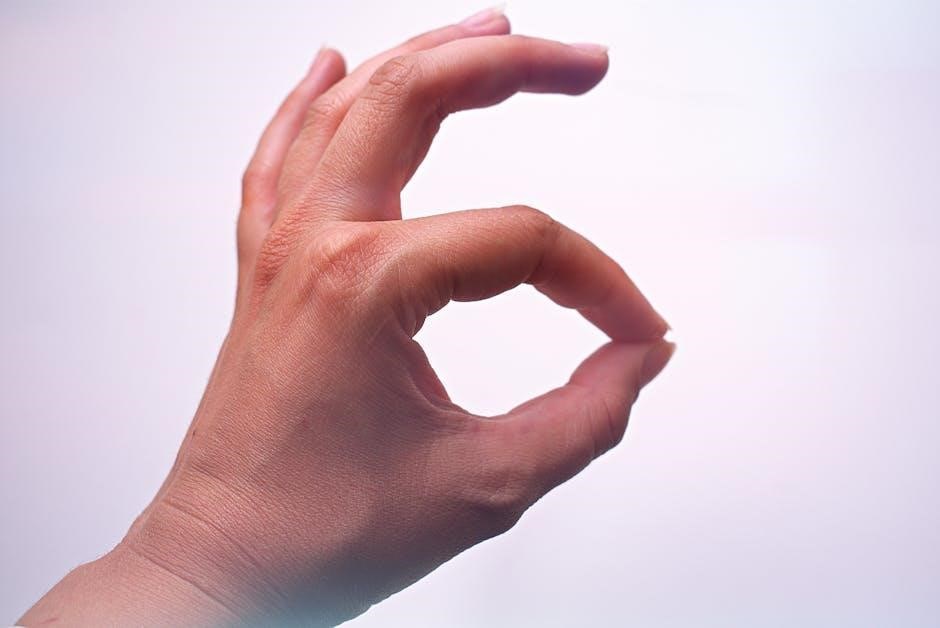
Trigger thumb is a condition causing pain and stiffness at the thumb’s base due to tendon inflammation․ It often affects individuals aged 40-60, especially those with repetitive thumb movements or underlying conditions like diabetes or rheumatoid arthritis, leading to impaired thumb mobility and discomfort during bending or straightening․
1․1 What is Trigger Thumb?
Trigger thumb, also known as stenosing tenosynovitis, is a condition where the tendon sheath of the thumb becomes inflamed, leading to pain and stiffness․ It occurs when the flexor tendon swells, causing difficulty in sliding through the pulley system, resulting in impaired thumb movement․ Symptoms include a clicking or popping sensation, a visible bump at the thumb’s base, and potential locking in a bent position․ It is common among individuals aged 40-60, especially those with repetitive hand movements or underlying conditions like diabetes or rheumatoid arthritis․ Trigger thumb can significantly impact daily activities, causing discomfort during bending or straightening of the thumb․
1․2 Common Causes and Risk Factors
Trigger thumb primarily arises from inflammation of the tendon sheath, often due to repetitive thumb movements or gripping activities․ Individuals aged 40-60 are at higher risk, particularly those engaging in tasks requiring prolonged thumb use, such as musicians or factory workers․ Underlying conditions like diabetes, gout, or rheumatoid arthritis also increase susceptibility․ Overuse, intense gripping, and prolonged thumb bending, as seen in sports like tennis, further contribute to its development․ Understanding these causes and risk factors is essential for early diagnosis and effective management of trigger thumb, helping to prevent progression and reduce the need for invasive treatments․
1․3 Symptoms and Diagnosis
Trigger thumb symptoms include pain at the base of the thumb, stiffness, and a clicking or popping sensation when moving the thumb․ In severe cases, a visible bump may appear, and the thumb may lock in a bent position․ Diagnosis typically involves a physical examination to assess thumb mobility and tenderness․ Imaging, such as X-rays or ultrasound, is rarely needed but may be used to rule out other conditions․ Early recognition of these symptoms is crucial for timely intervention and effective management of the condition, preventing further complications and improving treatment outcomes for individuals with trigger thumb․

Importance of Exercises in Managing Trigger Thumb
Exercises are crucial for improving thumb mobility, reducing pain, and strengthening muscles․ They help avoid surgery by addressing early symptoms and promoting long-term hand function and recovery․
2․1 Role of Exercises in Early Stages
In the early stages of trigger thumb, exercises play a vital role in restoring mobility and reducing discomfort․ Gentle stretches, such as thumb flex and extend movements, help maintain joint flexibility and prevent stiffness․ Strengthening exercises using elastic bands or resistance can improve tendon function, reducing the risk of further inflammation․ Early intervention through exercises can significantly alleviate symptoms, potentially avoiding the need for more invasive treatments like injections or surgery․ Consistency in performing these exercises is key to promoting healing and ensuring optimal thumb function․ Regular practice also helps prevent the progression of the condition, making recovery more manageable and effective․
2․2 Exercises as a Conservative Treatment Option
Exercises serve as a non-invasive and effective conservative treatment for trigger thumb, helping to reduce pain and inflammation without surgery․ Gentle stretches, such as thumb opposition and flexion-extension exercises, improve tendon mobility and reduce stiffness․ Strengthening exercises using elastic bands or resistance can enhance thumb function and prevent further deterioration․ These exercises are particularly beneficial for mild to moderate cases, offering a low-risk alternative to injections or surgery․ Consistency is key, as regular practice can significantly improve symptoms and restore normal thumb movement․ Exercises also empower individuals to manage their condition proactively, making them a cornerstone of conservative treatment plans․
2․3 Post-Surgery Rehabilitation Through Exercises

Following trigger thumb surgery, exercises are essential for restoring thumb mobility, strength, and function․ Gentle stretching exercises, such as thumb flexion and extension, help improve range of motion and reduce stiffness․ Strengthening exercises, like resisted thumb lifts, gradually rebuild muscle power․ These exercises are typically performed under the guidance of a healthcare professional to ensure proper healing and avoid re-injury․ Consistency in following a post-surgery exercise program is crucial for achieving full recovery and preventing long-term limitations․ Over time, these exercises help restore normal thumb movement, enabling individuals to return to daily activities and maintain hand functionality effectively․

Top Trigger Thumb Exercises
Key exercises include thumb stretches, elastic band resistance, thumb flex and extend, opposition stretches, and thumb lifts․ These exercises improve flexibility, strength, and mobility in the thumb․
3․1 Thumb Stretch
The thumb stretch is a simple yet effective exercise for managing trigger thumb․ To perform it, place your hand flat on a surface with your palm down․ Gently stretch your thumb away from your palm, holding the position for 10-15 seconds․ Repeat this motion 8-10 times, ensuring smooth, controlled movements․ This exercise helps improve thumb flexibility, reduce stiffness, and alleviate discomfort caused by trigger thumb․ Regular practice, ideally 2-3 times daily, can significantly enhance mobility and strength in the affected area without exacerbating the condition․
3․2 Elastic Band Thumb Exercises
Elastic band thumb exercises are highly effective for strengthening and improving thumb mobility․ Place an elastic band around your thumb and index finger, keeping your hand flat on a surface․ Slowly move your thumb away from your index finger to stretch the band, holding for 1-2 seconds before releasing․ Repeat this motion 10-15 times․ For added resistance, wrap the band around your thumb alone and pull it outward, then gently return to the starting position․ Perform this exercise 2-3 times daily to enhance thumb strength and flexibility, helping to alleviate trigger thumb symptoms and improve overall hand function without causing further irritation․
3․3 Thumb Flex and Extend
Thumb flex and extend exercises are simple yet effective for managing trigger thumb․ Start with your hand flat on a surface․ Gently flex your thumb into your palm, then extend it outward as far as comfortable․ Repeat this motion 10-15 times․ This exercise helps maintain thumb mobility and reduces stiffness․ Perform it 3-4 times daily to improve range of motion and strength without overexertion, making it ideal for early stages of trigger thumb treatment to prevent further complications and support recovery naturally․
3․4 Thumb Opposition Stretch
The thumb opposition stretch targets the thumb’s flexibility and strength․ To perform this exercise, touch the tip of your thumb to each fingertip one by one, forming a circular motion․ Hold each position for 2-3 seconds before releasing․ Repeat the sequence 8-10 times․ This stretch improves thumb mobility and reduces stiffness, especially in the early stages of trigger thumb․ It also enhances grip strength and coordination․ Perform this exercise 2-3 times daily to maintain optimal thumb function and aid in recovery․ Regular practice can help alleviate discomfort and prevent further complications․
3․5 Thumb Lifts
Thumb lifts are a simple yet effective exercise for managing trigger thumb․ To perform this exercise, place your hand flat on a surface with your palm down․ Slowly lift your thumb away from the table while keeping the rest of your hand still․ Hold the lifted position for 2-3 seconds, then gently lower your thumb back down․ Repeat this motion 8-10 times․ This exercise strengthens the muscles around the thumb and improves joint mobility․ It is particularly beneficial for reducing stiffness and restoring range of motion in the thumb․ Perform thumb lifts 2-3 times daily to support recovery and maintain thumb function;

Additional Tips for Managing Trigger Thumb
Self-massage, warm-ups, and splint use can aid recovery․ Gentle massage reduces swelling, while warm-ups prevent stiffness․ Splints immobilize the thumb, relieving strain during healing․
4․1 Self-Massage Techniques
Self-massage is a beneficial technique for managing trigger thumb․ Gently massage the base of the thumb with your opposite thumb, using circular motions․ Focus on the area where pain is most pronounced․ Apply moderate pressure to reduce swelling and stiffness․ Perform this for 5-10 minutes daily to improve circulation and tendon mobility․ Regular self-massage can help alleviate discomfort and prevent further inflammation․ It is a simple yet effective method to complement exercises and other treatments, promoting faster recovery and restoring thumb function․
4․2 Warm-Up Exercises Before Starting
Warm-up exercises are essential before beginning trigger thumb exercises to prevent pain and stiffness․ Start by gently stretching your fingers and thumb․ Make a fist and then release, repeating this motion several times․ Next, perform thumb circles by rotating your thumb in both clockwise and counterclockwise directions․ These exercises improve blood flow and flexibility, reducing the risk of aggravating the condition․ Spend about 5-10 minutes on warm-ups to ensure your thumb is ready for more intense exercises․ If you experience pain, stop and consult a healthcare provider to avoid further injury․
4․3 Use of Splints or Braces
Splints or braces are often recommended to manage trigger thumb by immobilizing the thumb and reducing movement․ These devices can help alleviate pain and prevent the thumb from locking in a bent position․ A splint may be worn at night to keep the thumb straight, allowing the tendon to rest and heal․ Additionally, splints can be used during periods of high hand activity to avoid aggravating the condition․ Regular use of a splint or brace can provide stability and reduce inflammation, aiding in the recovery process․ Always consult a healthcare provider to ensure proper fitting and usage, as improper use can lead to muscle atrophy․

Preventing Trigger Thumb
Preventing trigger thumb involves avoiding repetitive hand movements and strengthening thumb muscles through targeted exercises․ Regular breaks during repetitive tasks and ergonomic adjustments can also reduce risk․
5․1 Avoiding Repetitive Hand Movements
Avoiding repetitive hand movements is crucial in preventing trigger thumb․ Repetitive gripping or grasping, common in jobs like factory work or sports like tennis, can inflame the tendon sheath․ Taking regular breaks, using ergonomic tools, and alternating tasks can reduce strain․ Modifying activities to minimize thumb bending and forceful gripping helps prevent inflammation․ Awareness of hand posture and workload distribution can also mitigate risks, promoting long-term thumb health and function․ This proactive approach reduces the likelihood of developing trigger thumb and its associated pain and stiffness․
5․2 Strengthening Hand and Thumb Muscles
Strengthening hand and thumb muscles is essential for preventing trigger thumb․ Weak muscles can lead to overuse and strain, increasing the risk of tendon inflammation․ Exercises like thumb lifts, elastic band resistance, and ball squeezes help build strength without causing strain․ Using a rubber band around the thumb and fingers provides resistance, enhancing muscle endurance․ Gentle exercises improve grip strength and dexterity, reducing the likelihood of repetitive strain injuries․ Stronger muscles also stabilize the thumb, protecting the tendon from excessive wear․ Regular practice of these exercises promotes overall hand health and reduces the risk of developing trigger thumb․

When to Seek Medical Help
Seek medical help if experiencing severe thumb pain, limited mobility, or locking․ Consult a healthcare provider for hydrocortisone injections or surgery in persistent cases․
6․1 Indications for Hydrocortisone Injections
Hydrocortisone injections are recommended for severe trigger thumb cases where pain and stiffness persist despite conservative treatments․ These injections reduce inflammation in the tendon sheath, restoring thumb mobility and alleviating locking or clicking sensations․ They are particularly effective for individuals who cannot undergo surgery or prefer minimally invasive options․ However, injections may need to be repeated and are not suitable for all patients, especially those with certain medical conditions․ Consulting a healthcare provider is essential to determine if this treatment is appropriate․
6․2 Surgical Options for Severe Cases
Surgery is often necessary for severe trigger thumb cases where conservative treatments fail to provide relief․ The procedure typically involves releasing the affected tendon sheath to eliminate obstruction and restore smooth thumb movement․ Performed under local anesthesia, it is minimally invasive and highly effective in resolving persistent locking or pain․ Patients usually experience rapid improvement post-surgery, with full recovery supported by post-operative exercises․ However, surgery is generally reserved as a last resort for cases where the thumb is locked in a bent position or significantly impacts daily activities․ Consulting a specialist is crucial to determine if surgery is the appropriate course of action․